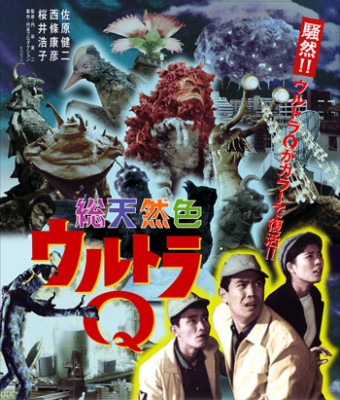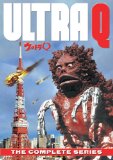| Reviews & Columns |
|
Reviews DVD TV on DVD Blu-ray 4K UHD International DVDs In Theaters Reviews by Studio Video Games Features Collector Series DVDs Easter Egg Database Interviews DVD Talk Radio Feature Articles Columns Anime Talk DVD Savant Horror DVDs The M.O.D. Squad Art House HD Talk Silent DVD
|
DVD Talk Forum |
|
|
| Resources |
|
DVD Price Search Customer Service #'s RCE Info Links |
|
Columns
|
|
|
Ultra Q - The Complete Series
Ultra Q was somewhat different. Most episodes feature a giant, city-thrashing monster of some kind, but a few do not. There's no Ultraman-type giant superhero, and the series was photographed in both 35mm and black and white unlike those that followed, which were (for the next several decades anyway) filmed in 16mm and color. The tone of the show was more along the lines of The Outer Limits and the later The X-Files than all of the subsequent "Ultra" shows, which were more like a cross between Superman and Gerry and Sylvia Anderson's Supermarionation epics (e.g., Thunderbirds) being produced concurrently in England.
Because it was Tsuburaya's first TV series, and because it deviates so sharply from the formula of the later superhero shows, Ultra Q is unusually intriguing and ambitious. Viewers who would normally avoid Japanese superhero-type shows might want to give this a try.
Due to Byzantine rights issues that have been the subject of decades-long litigation, Shout! Factory licensed Ultra Q not from the series' current Japanese owners but rather through Golden Media Group, acting as an agent for the Thai businessman who claims international rights to nearly all of Tsuburaya Productions early output. This has resulted in imperfect video transfers, though it's less problematic in the case of Ultra Q. More on this below.
The series is loosely structured to allow a greater variety of teleplays than later Tsuburaya shows. Kenji Sahara (Rodan, The Mysterians) stars as Jun Manjome, a pilot for the Hoshikawa Air Service who with partner Ippei Togawa (Yasuhiko Saijo) often teams up with Yuriko Edogawa (Hiroko Sakurai, later Akiko Fuji on Ultra Man), a spunky reporter for the Daily News, whose editor, Seki (Yoshifumi Tajima, Sahara's lackey in Godzilla vs. The Thing), encourages her to investigate strange phenomena. However, these characters are sometimes way off on the sidelines and once in a while they don't appear at all.
The half-hour series was shot during 1965 and premiered on Japan's TBS network (co-producers with Tsuburaya Productions) during the New Year's holiday, on January 2, 1966. Only 28 half-hour episodes were produced. The reason for this was simple: shows featuring giant, rampaging monsters invariably scored higher ratings, and Tsuburaya was encouraged to scrap Ultra Q in favor of a new series that would feature giant monster battles every week. The result was Ultra Man (1966-67), which debuted exactly two weeks after Ultra Q ended.
Most of the episodes feature a giant monster of one sort or another, but not all do. "Grow! Turtle," for instance, is a modern retelling of Urashima Taro, a Japanese folk story, and features a turtle that isn't much bigger than a Galápagos tortoise, though that show does briefly feature a dragon (played by one of the marionettes from 1963's Atragon). In another show, "The 1/8 Project," Yuriko finds herself reduced to one-eighth her size as part of a bizarre scientific experiment to solve the population explosion, while "The Spider Baron," despite the presence of oversized tarantulas, is basically a haunted house story.
Episodes like "Grow! Turtle" and "S.O.S. Mt. Fuji," about the search for a missing boy lost for years in the dense forests of Mt. Fuji only to grow into Tarzan-like manhood, have a distinctly Japanese flavor and make regional, cultural, and historical references lost on bemused Western viewers. The more bizarre episodes, and many are quite bizarre, probably didn't help sell it abroad. The first episode, "Defeat Gomess!" is a bit more the conventional Japanese giant monster story, but it was episode three, "The Gift from Space," which was dubbed into English in an attempt to sell Ultra Q to American distributors.
Broadcast rights were eventually purchased by CBS, who dubbed the rest of the series into English before losing interest and selling off their holdings to United Artists Television. They found Ultra Man, also part of the deal, more viable for syndication and dubbed and distributed that instead, leaving Ultra Q in limbo for decades.
Reportedly Ultra Q was the most expensive Japanese television series produced up to that time, and that might well be true. The series is in some respects more varied and lavish that Ultra Man or Ultraseven, and perhaps only Tsuburaya's later Mighty Jack (1968), a short-lived attempt to create an hour-long, Thunderbirds type series in Japan, was as elaborate and polished.
Though a co-production between Tsuburaya Productions and TBS, Eiji Tsuburaya himself was still concurrently working for Toho Studios and somehow through that relationship acquired the acting services of Toho contractees, borrowed props, sound effects, monster costumes, stock footage, and just about anything else at Toho he could lay his hands on.
The result of this is that in practically every episode eagle-eyed viewers can spot miniatures, parts of monster costumes, hear familiar sound effects, etc. retooled for use in Ultra Q. The title monster in "Defeat Gomess!" for instance, is obviously a modified Godzilla suit, specifically the one used in both Godzilla vs. the Thing and Ghidrah, The Three-Headed Monster. (An altered Godzilla costume also turns up in an episode of Ultra Man.) The second episode features a revamped King Kong skin from King Kong vs. Godzilla, while another show, "The Rainbow's Egg," revamps the Baragon monster suit seen in Frankenstein Conquers the World, with sound effects created for both that monster and Godzilla, whose "voice" also dubs other Ultra Q critters.
Conversely, there had to have been some formal business arrangement between Tsuburaya/TBS and Toho about the use of Toho actors, who completely dominate the casts. Sahara had been groomed for stardom by Toho in the late 1950s but when that didn't take he became a busy, reliable supporting actor in myriad genres. Because kaiju eiga director Ishiro Honda liked and cast him in most of his sci-fi films, Sahara became somewhat typed, and this undoubtedly led to his casting as the de facto lead. Likewise, Hiroko Sakurai was one of several dozen ingénues at Toho, often playing small parts in their white-collar comedies.
Ultra Q, even more than subsequent Tsuburaya series, is like a Who's-Who of Toho players. Among the guest stars are Yoshio Tsuchiya, Masanori Nihei, Jun Tazaki, Minoru Takada, Sachio Sakai, Nami Tamura, Susumu Kurobe, Keiko Sawai, Akiko Wakabayashi, Akihiko Hirata, Fuyuki Murakami, Akiji Kobayashi, Susumu Fujita, Machiko Naka, Akira Kubo, Yoshio Kosugi, Hiroshi Koizumi, and Eisei Amamoto.
Interestingly, the directors and special effects directors on Ultra Q draw from somewhat different sources than later "Ultra" shows. As with Ultra Man, Eiji Tsuburaya takes a supervisory role and many shows are directed by oldest son Hajime, others are helmed by prolific Toho assistant director, Koji Kajita, while cinematographer Hajime Koizumi, normally part of Ishiro Honda's first unit group, not Tsuburaya's, directed some shows' special effects unit.
Video & Audio
The full-frame, black and white presentations of Ultra Q are generally pretty good but still compromised due to incredibly tangled legal problems never satisfactorily resolved. As noted in previous reviews of Tsuburaya shows, Thai businessman Sompote Saengduenchai claims all rights outside of Japan to all "Ultra" TV series created from prior to 1974-75. He had partnered with then-company president Noboru Tsuburaya (another of Eiji's sons) on a few Japanese-Thai co-productions and had licensed some Tsuburaya-produced shows for Thai television. Many believe Saengduenchai was foolishly left alone in Tsuburaya's office long enough for Saengduenchai to steal the company's sacred hanko, the official and unique company seal used to finalize legally binding contracts.
Regardless, Saengduenchai made no claims on these alleged rights for more than 20 years. That is, until immediately after the death of Noboru Tsuburaya, the only other "witness" to the supposed agreement. The alleged contract was viewed by most as an obvious forgery, a document rife with misspelled names and series titles, and even the company's name was spelled and abbreviated incorrectly. Further, handwriting experts dismissed Noboru Tsuburaya's signature on the agreement as a forgery. Incredibly though, courts in Thailand and Japan sided with Saengduenchai, largely because of that company seal, awarding him certain but not unlimited rights, and various appeals in both countries have clouded the ownership to nearly all of Tsuburaya's pre-1975 library. Potential licensees outside Japan have been understandably skittish about signing an agreement with either party.
All of this explains why BCI Eclipse's DVDs of Ultra Man in 2008, Shout! Factory's release of Ultra Seven last year and now Ultra Q all utilize compromised video masters. Each apparently source material provided to them not by Tsuburaya or TYO (who bought Tsuburaya Productions in 2007), but rather from Chaiyo, Saengduenchai's company, via intermediary Golden Media Group. In short, heirs to Tsuburaya Productions receive no licensing fees, nor were they involved in this release at all. So acrimonious is the relationship between Tsuburaya and Chaiyo, some reports indicate the latter provided masters ripped from commercially available Japanese DVDs rather than first-generation clones derived from original film elements, a theory that makes sense when one considers the picture quality.
Partly because it was shot in 35mm, partly because it's in black and white, Ultra Q fares better on DVD than either Ultra Man or Ultraseven, though the limitations of this second-generation dupe becomes obvious whenever there's sudden movement and distracting ghosting appears. Still, it's disheartening to consider that an apparently gorgeous Blu-ray of the series was released in Japan last year while Americans are stuck with inferior transfers solely due to rights issues. Audio-wise, the Japanese-only tracks with English subtitles sound and read pretty well, though the subtitles often don't synch up to the dialogue precisely, while at other times they fly by at lighting speed trying to keep pace. The show is spread across five single-sided DVDs.
Extra Features
None. Perhaps a booklet or other insert was planned, as nowhere on the packaging or the discs themselves is there even a list of episode titles, let alone air dates, synopses, etc., the kind of thing included on past releases. I ended up printing up a list and sticking in the DVD case to keep track of what I had seen.
Parting Thoughts
Complaints aside, Shout! is to be applauded for releasing Ultra Q at all, giving the series its first American exposure after nearly half a century. The transfer imperfections are occasionally distracting but minor, and the show itself is interesting, polished, and certainly unusual. Highly Recommended.
Stuart Galbraith IV is a Kyoto-based film historian whose work includes film history books, DVD and Blu-ray audio commentaries and special features. Visit Stuart's Cine Blogarama here.
|
| Popular Reviews |
| Sponsored Links |
|
|
| Sponsored Links |
|
|
| Release List | Reviews | Shop | Newsletter | Forum | DVD Giveaways | Blu-Ray | Advertise |
|
Copyright 2024 DVDTalk.com All Rights Reserved. Legal Info, Privacy Policy, Terms of Use,
Manage Preferences,
Your Privacy Choices | |||||||















